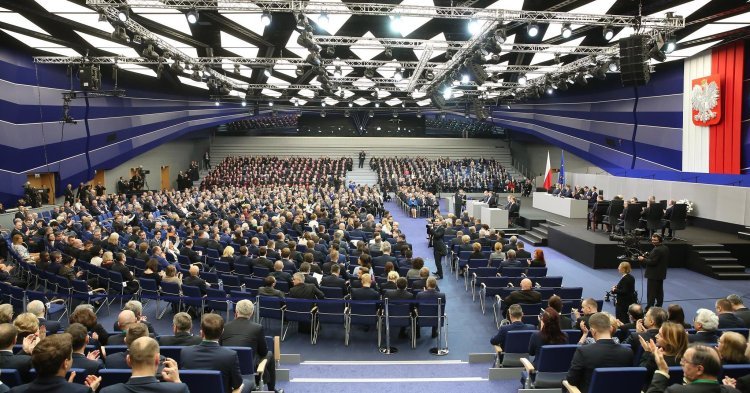An indisputable victory for the PiS?
The president of the PiS, Jarosław Kaczyński, should be happy with the results of the election. By receiving 43.6% of the vote, the politicians gathered under the umbrella of Law and Justice have gained the highest vote share by one group since the end of communism in Poland. PiS maintains a narrow majority of 235 out of 460 seats in the Sejm that allows it to govern autonomously during its second four year term. Even though the PiS lost its majority in the Senate, it is still a force to be reckoned with.
However, the victory of PiS must be put into perspective: the alliance only has a majority in the Sejm because of the Polish electoral system. Deputy Prime Minister and member of the PiS parliamentary group, Jaroslaw Gowin, is aware of this and states that: “More than half of Polish people [58% if you add all the opposition votes together] voted against us. This is a message that we need to analyse.”
Standing against the PiS is an opposition strongly divided between centrists and the left who have broken up their ‘sacred’ coalition of pro-European forces. This attempted union did not work out, as the European coalition only reached 38.5% of votes (around 10 points less than their last vote), whereas PiS, the people’s party and the far right party got 45.4%. Although the Civic Platform, the centrist alliance in power before 2015, remains the primary opposition, it was beaten and lost 32 of its 166 seats, which resulted in it losing some of its power in the Polish parliament. Despite this, the Polish people’s party was the biggest loser. It barely met the threshold of 8% needed for a coalition to be allowed into parliament and lost almost half of its MPs (28 of 58). Nevertheless, the vote saw the return of the left coalition in Parliament, which has acquired 49 seats and has become the third power in the Sejm, as well as a far right group with 11 MPs that has been excluded from parliament since 2007.
Even though they have a collective 58% of the vote, the opposition has not held its own. The conservatives have an overwhelming lead of 16 points over the centrist coalition.
A convincing track record?
The victory of the PiS is explained by their good track record on the country’s economic situation, one of the main focuses of their campaign. Poland’s economy is doing very well: the country has seen a growth of 4% in 2018 after a strong 2017. Taking advantage of this growth, the government spent 25 billion złotys (5.8 billion euros) in welfare each year during their last term. After he won the election, Jarosław Kaczyński pledged to continue the increase of minimum wage, which had started in his last term, to 4,000 złotys gross by 2023 (916 euros, rather the current 480 euros) and bring Poland’s standard of living in line with western Europe within 10 years.
Faced with these successes and proposals, the opposition, notably the liberals from the Civic Platform, have found it difficult to offer an alternative, partly because the PiS has put in place a pro-business program similar to the one the Civic Platform spearheaded under the previous government. The Civic Platform does not have any other credible economic suggestions. Instead, it focuses on economic and social proposals that are unpopular with the vast majority of the population. For example, they have a campaign for defending LGBT rights, which are met by counter demonstrations by the far right and the PiS who accuse the LGBT community of being a “threat to the traditional family” in Poland.
PiS’s social policy is widely accepted. The government established a programme called 500+ in 2019, which offers parents 500 złotys per month for their second child no matter what their income is. After 6 months in effect, the birth rate has gone up, showing that the reform has widespread approval. The opposition could not bridge the gap between urban and rural, which is very important in Poland. The agricultural electorate was very receptive to the project “the Poland of the good old days” (one of PiS’s official campaign slogans), which promised subsidies and a price increase on milk, a far cry from the environmental concerns of the centre or the left.
The electoral system gives big parties preferential treatment
Other variables need to be taken into account to fully explain PiS’s victory.
Poland’s electoral system encourages big parties: each party has to surpass a 5% threshold or it gets no MPs. This explains, for example, how the People’s Party lost half its MPs despite its share of the vote in the election only dropping 5.4%. Thus parties have an interest in forming coalitions so that they can pass the 5% threshold, however, if they do that they are subject to higher, more restrictive threshold of 8%.
During the legislative elections of 2019, all the big parties that made coalitions would have had to surpass the 8% threshold. However, only the Civic Platform was subject to the threshold because it officially declared that it was in a coalition. The other coalitions were informal so they only had to contend with a threshold of 5%. The vote share that the Civic Platform had would have been affected by this phenomenon.
A threat to democracy?
Another crucial element in the Polish elections was the revision of the Polish constitution into a more authoritarian version. Thanks to its success in the elections, PiS is free to continue its pursuit of undermining democracy during its second term.
Fearful of this possibility, the Civic Platform had called for an “act of democratic renovation” during the campaign, seeing the election as crucial for the future of democracy. On the other hand, the leader of the PiS has confirmed that he wants to “bring Budapest to Warsaw” by creating a strong, centralised government in Poland, inspired by Viktor Orbán’s Hungarian model. The government has already started to put several reforms in place in this vein, with the constitutional revision of 2016 that increased the influence of the state over the Supreme Court, the High Council of the Judiciary and the courts, institutions responsible for appointing members of the judiciary. The reform caused backlash on the level of the EU and Juncker triggered article 7 of the European Union Treaty against Poland, without many concrete consequences.
The question remains as to whether PiS will continue its constitutional reform even if that would mean reinforcing its Christian values against liberal European principals deployed by a “globalised elite” and a “Brussels technocracy”.
Throughout the campaign, the opposition has also expressed concern about Polish public media. Since the media reform in 2016, public media is increasingly used as a tool to spread government propaganda to promote their policies. It is now difficult for the general population to find out what is really happening in their country from public media, even though the freedom of the press is still technically guaranteed.
Despite these recurring attacks against the principles of rule of law and the separation of powers, the conflict with the European Commission, the purges in the Civil Service, the stranglehold PiS has on society, the country has never done so well economically. PiS has been able to restore Polish dignity with the 500+ plan’s scheme of ‘rewards’, rather than handouts.
A complicated political future
The centre, left, people’s party, and far right groups now all have seats in the Sejm. Greater diversity in parliament is good news for democracy. The diversity of Polish society is better represented and the different groups now have 5 years to create an alternative to PiS, while benefiting from having a platform.
However, the opposition remains weak and has not learned from its humiliating defeat in the European elections. The left is in a difficult position and the Civic Platform is torn between supporting the economic program and denouncing PiS’s social plan.
The two groups are content to simply complain about everything PiS does without offering an alternative. But it is not enough to simply expose the wrongdoings of the party in power to undermine them. Both main opposition parties need to drastically change for them to have any hope of re-establishing themselves with the electorate. Unlike those two parties, the far right is constantly progressing, relying on a reactionary program where they emphasise the divisions within Polish society and express their highly negative view of globalisation and the EU.
Currently, it is very challenging to even try to predict the future of Polish politics if the PiS pursues its reforms and if the opposition changes its ways. The next time voters will head to the polling stations for a presidential election is May 2020.


Follow the comments: |
|
